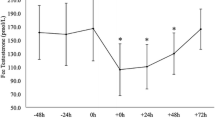Abstract
The effects of resistance exercise on the nocturnal responses of cortisol (CO), testosterone (TEST), human growth hormone (hGH), and thyroid hormones (T3, T4) were examined in eight trained weight lifters. Each subject completed two trials using a counterbalanced design: a control, no exercise trial (CON) and a heavy resistance exercise session of three sets of six exercises to exhaustion (RE). The exercise session took place between 1900 and 2000 hours. Blood was sampled prior to and at 20-min intervals after RE. For both trials blood was sampled at hourly intervals from 2100 hours until 0700 hours. The hGH and CO concentrations were increased up to 40-min post-exercise (P < 0.05), but returned to resting levels 1 h post-exercise. Nocturnal hGH concentration was not affected by RE (P > 0.26) and peaked at 0200 hours and declined until 0700 hours. Similarly, the CO responses were similar between the trails (P > 0.14). This CO concentrations declined from 2200 hours until 0100 hours, then increased steadily until 0700 hours. The TEST concentrations during both trials rose steadily from 2200 hours until 0700 hours; however, the rise in TEST from 0500–0700 hours during RE was greater than during the CON trails (P = 0.059). The T3 concentrations were unchanged by exercise and were similar at all times between trails. The T4 concentrations were elevated for 20 min after RE; however nocturnal T4 concentrations were lower after RE than during CON. These results would suggest that bGH and CO may have limited nocturnal reactivity to resistance exercise. However, the nocturnal alterations of TEST and T4 after resistance exercise, although small, may have implications for muscle anabolism.
Similar content being viewed by others
References
Balsam A, Leppo LE (1975) Effect of physical training on the metabolism of thyroid hormones in man. J Appl Physiol 38:212–215
Boone JB, Lambert CP, Flynn MG, Michaud TJ, Rodriguez-Zayas JA, Anders FF (1990) Resistance exercise effects on plasma cortisol, testosterone and creatine kinase activity in anabolic-androgenic steroid users. Int J Sports Med 11:293–297
Danhaive PA, Rousseau GG (1988) Evidence for sex-dependent anabolic response to androgenic steroids mediated by muscle glucocorticoid receptors in the rat. Steroid Biochem 29:575–581
Ekins R (1990) Measurement of free hormones in blood. Endocrinol Rev 11:5–15
Fahey TD, Rolph R, Moungmee P, Nagel J, Mortara S (1976) Serum testosterone, body composition and strength of young adults. Med Sci Sports 8:31–34
Franchimont P (1983) Regulation of gonadal androgen secretion. Horm Res 18:7–17
Guezennec Y, Leger L, Lhoste F, Aymonod M, Pesquies PC (1986) Hormone and metabolic responses to weight-lifting training sessions. Int J Sports Med 5:246–249
Hakkinen K, Pakarinen A, Alen M, Komi PV (1985) Serum hormones during prolonged training of neuromuscular performance. Eur J Appl Physiol 53:287–293
Hakkinen K, Pakarinen A, Alen M, Kauhanen H, Komi PV (1988) Neuromuscular and hormonal adaptations in athletes to strength training in two years. J Appl Physiol 65:2406–2412
Hedge GA, Colby HD, Goodman RL (1987) Clinical endocrinology. Saunders, Philadelphia, p 113
Inoue K, Yamasaki S, Fushiki T, Okada Y, Sugimoto E (1994) Androgen receptor antagonist suppresses exercise-induced hypertrophy of skeletal muscle. Eur J Appl Physiol 69:88–91
Irvine CHG (1968) Effect of exercise on thyroxine degradation in athletes and non-athletes. J Clin Endocrinol 28:942–948
Jackson AS, Pollock ML (1978) Generalized equations for predicting body density of men. Br J Nutt 40:497–504
Kraemer RR, Kilgore JL, Kraemer GR, Castracane VD (1992) Growth hormone, IFG-I, and testosterone responses to resistive exercise. Med Sci Sports Exerc 24:1346–1352
Kraemer WJ (1992) Endocrine responses and adaptations to strength training. In: Komi PV (ed) Strength and Power in Sport. Human Kinetics, Champaign, Ill., pp 291–304
Kraemer WJ, Noble BJ, Clark MJ, Culver BW (1987) Physiologic responses to heavy-resistance exercise with very short periods of rest. Int J Sports Med 8:247–252
Kraemer WJ, Marchitelli L, McCurry D, Mello R, Dziados JE, Harman E, Frykman P, Gordon SE, Fleck SJ (1990) Hormonal and growth factor response to heavy resistance exercise. J Appl Physiol 69:1442–1450
Kraemer WJ, Gordon SE, Fleck SJ, Marchitelli LJ, Mello R, Dziados JE, Friedl K, Harman E (1991) Endogenous anabolic hormonal and growth factor responses to heavy resistance exercise in males and females. Int J Sports Med 12:228–235
Lemon PWR, Yarasheski KE, Dolny DG (1984) The importance of protein for athletes. Sports Med 1:474–484
McMurray RG, Newbold E, Bouloux P, Besser GM, Grossman A (1991) High-dose naloxone modifies cardiovascular and neuroendocrine function in ambulant subjects. Psychoneuroendocrinology 16:447–455
Mehls O, Tonshoff B, Kovacs G, Mayer C, Schurek J, Oh J (1993) Interaction between glucocorticoids and growth hormone. Acta Paediatr [Suppl] 388:77–82
Newsholme EA, Leech AR (1983) Biochemistry for the medical sciences. Wiley, New York, pp 668–673
Pakarinen A, Alen M, Hakkinen K, Komi P (1988) Serum thyroid hormones, thyrotropin and thyroxine binding globulin during prolonged strength training. Eur J Appl Physiol 57:394–398
Parker LN, Odell WD (1979) Evidence for existence of cortical androgen-stimulating hormone. Am J Physiol 236:E616-E620
Pyka G, Wiswell RA, Marcus R (1992) Age-dependent efffect of resistance exercise on growth hormone secretion in people. J Clin Endocrinol Metab 75:404–407
Rone JK, Dons RF, Reed HL (1992) The effect of endurance training on serum triiodothyronine kinetics in man: physical conditioning marked by enhanced thyroid hormone metabolism. Clin Endocrinol 37:325–330
Schwab RS, Johnson GO, Housh TJ, Kinder JE, Weir JP (1993) Acute effects of different intensities of weight lifting on serum testosterone. Med Sci Sports Exerc 25:1381–1385
Skierska E, Ustupska J, Biczowa B, Lukaszewska J (1976) Effect of physical exercise on plasma cortisol, testosterone and growth hormone levels in weight lifters. Endokrynol Pol 2:159–165
Weiss LW, Cureton KJ, Thompson FN (1983) Comparison of serum testosterone androstenedione responses to weight lifting in men and women. Eur J Appl Physiol 50:413–419
Author information
Authors and Affiliations
Rights and permissions
About this article
Cite this article
McMurray, R.G., Eubank, T.K. & Hackney, A.C. Nocturnal hormonal responses to resistance exercise. Eur J Appl Physiol 72, 121–126 (1995). https://doi.org/10.1007/BF00964126
Accepted:
Issue Date:
DOI: https://doi.org/10.1007/BF00964126



